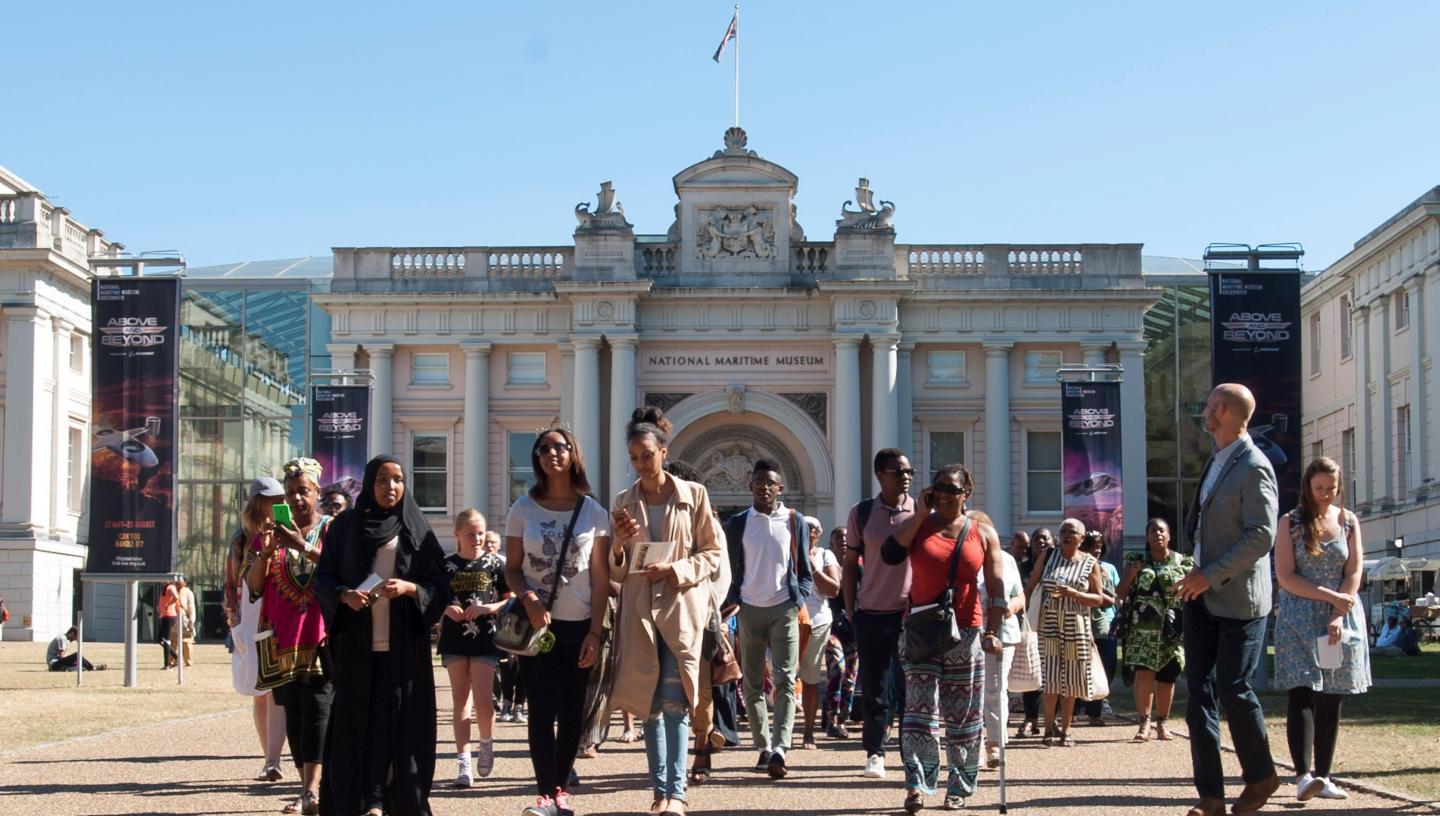
On August 23rd 2017, International Slavery Remembrance Day, hundreds of people walked from the gates of the National Maritime Museum, past the Old Royal Naval College and the statue of King George II to face the river Thames. They stood together in remembrance of the families separated, people displaced and the millions of lives lost as a result of the Transatlantic Slave Trade.
By Navjot Mangat, Communities Interpretation and Research Advocate
Throughout the duration of the procession only one banner was held for onlookers to see. The banner depicted an Adinkra symbol, a visual representation of a saying or proverb used by the Akan people of Ghana, West Africa. The symbol in question was a bird, moving forwards, its head looking backwards with a small object in its beak, this symbol is the Sankofa.

Last year, working with artist facilitator Merissa Hamilton, we engaged with young people and families to decorate and create the Sankofa banner that would be used in the procession.
What does it mean?
“Se wo were fi na wosan kofa a yenkyi” / “It is not wrong to go back for that which you have forgotten”Akan proverb
The Sankofa represents the importance of retaining or remembering knowledge from one’s past whilst still moving forward. The symbol is a reminder that our past is always with us and that the past, present and future are all connected.
As the African and Caribbean diaspora has spread across the globe and communities have grown, the Sankofa has also served as an icon of a rich cultural heritage and has often been used as a symbol that represents the reclamation of, and a re-connection with, cultural identity.
What can museums learn from Sankofa?
As a national museum, applying the principles of Sankofa to our work with collections and audiences is incredibly important.
Every year, millions of visitors go to museums to engage with objects and connect with stories and histories that museum professionals have chosen to showcase.
As part of the development process for galleries and exhibitions, museums have the responsibility of selecting the histories, perspectives and narratives that they feel their audiences want to see and engage with.
As our understanding of history is always changing so are the needs and wants of audiences; the information that was considered to be important, as well as the language that was used, twenty years ago may not be relevant or appropriate today.
A failure to address this change could result in the development of a space that fails to engage with audiences and could potentially damage the reputation of the museum with people that have a connection to the story being presented.
Understanding the past and moving forward
How does reflecting on traditional narratives, and reaching out to communities for new perspectives, allow both museums and communities to move forward?
For communities, museums and their collections have the potential to inspire and empower, to be a space for reflection and discussion. By taking ownership of the narratives presented and the space they’re presented in, communities can have a say in how they are represented to millions of people. By challenging traditional narratives of history and employing community consultation as part research and interpretation, museums can be agents of positive reinforcement and empowerment amongst historically under-represented and often misrepresented communities.
For museums, it allows them to build relationships with communities, it adds relevancy to collections; it encourages use of museums as inclusive spaces and breaks down barriers to access. By looking back and searching for histories that were initially 'forgotten' museums can grow as institutions. Ultimately, applying the principles of Sankofa to our work with collections and audiences is incredibly important, not only for the sake of our visitors, but also for the sustainability and relevance of museums moving forward.
International Slavery Remembrance Day
The legacy of the Transatlantic Slave Trade can be found all around us today; it is a tangible legacy and survives through architecture, art, language and people. Its history is one that is evocative, powerful and deeply personal.
On August 23rd, the National Maritime Museum takes part in International Slavery Remembrance Day. The date itself is in honour of the first successful rising of enslaved peoples in the French colony of Saint Domingue, Hispaniola, known today as Haiti. This story stands against the often propagated narrative of enslaved peoples as victims who were emancipated by a handful of benevolent European men. Instead, the story of the Haitian Revolution places enslaved Africans and their descendants at the centre of this historic event as catalysts for change. This story, as well as many others of risings and resistance, remind us that the story of the transatlantic slave trade is not only about brutality and loss, but also about the resilience, survival and strength of a peoples.
At the National Maritime Museum, our local African and Caribbean communities are at the heart of consultation and testing when we work on exploring stories and legacies of the Transatlantic Slave Trade. By doing this we make sure that our programming and content is appropriate and relevant to our audiences. By understanding the needs of the community we are able to develop programming that directly serves our local audiences. As well as this, through consultation we are able to better understand what stories and narratives the community wants to see more of in the Museum, such as the stories of resistance and inspirational black leaders.